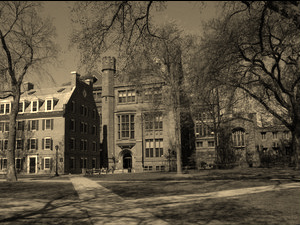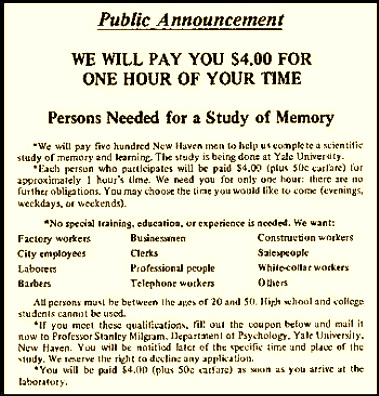Life at Yale University

May 3, 1960
While considering a job at Harvard for the coming academic year, Milgram received a letter from Leonardo Doob, a social psychologist and senior member of Yale University's Psychology Department, writing to tell him about a job opening for an assistant professor of social psychology in the department, and asking him to consider. After meeting with Doob, Milgram decided he'd be more interested in working at Yale than he would be at Harvard, and accepted the position (Blass 60).
According to Blass, Milgram enjoyed the freedom he had at Yale. He only taught one psychology seminar on Tuesdays to a small class, and was advising "ten students who were writing their senior honors theses" (63). He found a lot of free time to do the research that truly interested him (64).
While considering a job at Harvard for the coming academic year, Milgram received a letter from Leonardo Doob, a social psychologist and senior member of Yale University's Psychology Department, writing to tell him about a job opening for an assistant professor of social psychology in the department, and asking him to consider. After meeting with Doob, Milgram decided he'd be more interested in working at Yale than he would be at Harvard, and accepted the position (Blass 60).
According to Blass, Milgram enjoyed the freedom he had at Yale. He only taught one psychology seminar on Tuesdays to a small class, and was advising "ten students who were writing their senior honors theses" (63). He found a lot of free time to do the research that truly interested him (64).

The ad Milgram put in the New Haven Register to attract experiment participants
Milgram had already decided that he was going to study obedience to authority while he was at Princeton working with Solomon Asch, and he found that, unlike Asch's studies, he wanted to make his "humanly significant" (Blass 62). Because Milgram was Jewish and could identify with that group, his interest in obedience was inspired by the Holocaust. He said, "The impact of the Holocaust on my own psyche energized my interest in obedience and shaped the particular form in which it was examined" (Blass 62). This was one way for him to accomplish his goal of having his work become significant to everybody.
Blass wrote that Milgram, after much planning and pilot studies, formally applied with a letter of inquiry to the National Science Foundation, and his plans for his first real Electric Shock Experiment he wanted to conduct were approved in May 1960. That summer, Milgram began displaying ads to recruit adult residents of the New Haven community in the New Haven Register and by direct mail solicitations. He ended the month of June with 300 volunteers (69-70).
From there, his famous Electric Shock Experiments began.
Blass wrote that Milgram, after much planning and pilot studies, formally applied with a letter of inquiry to the National Science Foundation, and his plans for his first real Electric Shock Experiment he wanted to conduct were approved in May 1960. That summer, Milgram began displaying ads to recruit adult residents of the New Haven community in the New Haven Register and by direct mail solicitations. He ended the month of June with 300 volunteers (69-70).
From there, his famous Electric Shock Experiments began.
